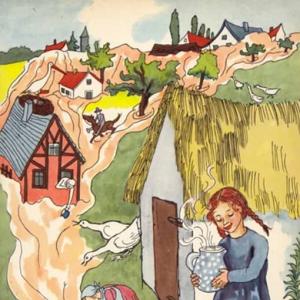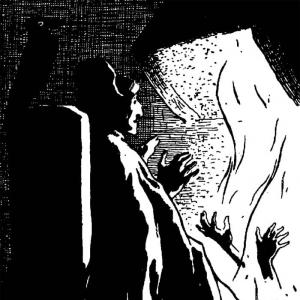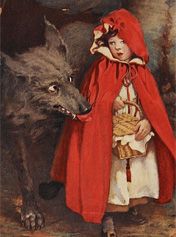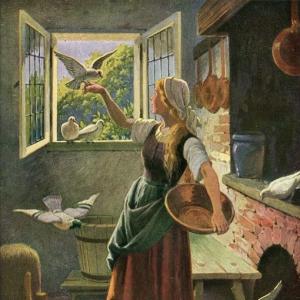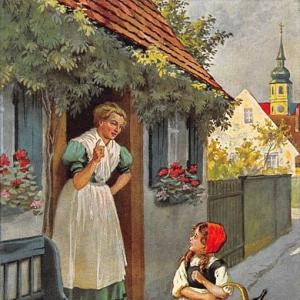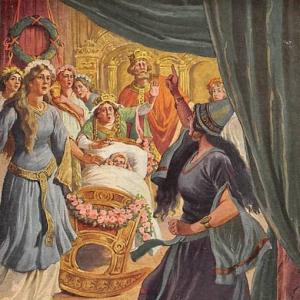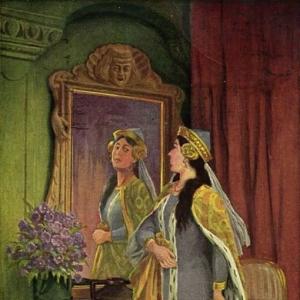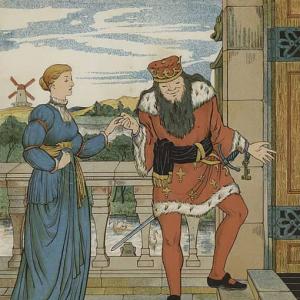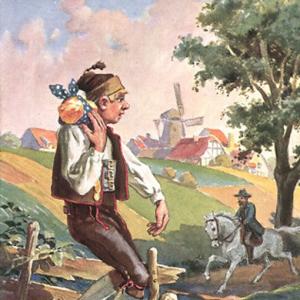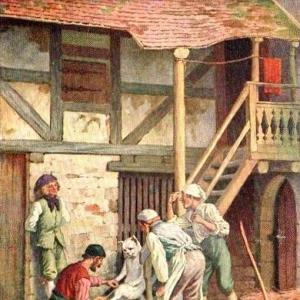Reading time: 3 min
It happened that the cat met the fox in a forest, and as she thought to herself, „He is clever and full of experience, and much esteemed in the world,“ she spoke to him in a friendly way. „Good-day, dear Mr. Fox, how are you? How is all with you? How are you getting through this dear season?“ The fox, full of all kinds of arrogance, looked at the cat from head to foot, and for a long time did not know whether he would give any answer or not. At last he said, „Oh, thou wretched beard-cleaner, thou piebald fool, thou hungry mouse-hunter, what canst thou be thinking of? Dost thou venture to ask how I am getting on? What hast thou learnt? How many arts dost thou understand?“ – „I understand but one,“ replied the cat, modestly. „What art is that?“ asked the fox. „When the hounds are following me, I can spring into a tree and save myself.“ – „Is that all?“ said the fox. „I am master of a hundred arts, and have into the bargain a sackful of cunning. Thou makest me sorry for thee; come with me, I will teach thee how people get away from the hounds.“ Just then came a hunter with four dogs. The cat sprang nimbly up a tree, and sat down on top of it, where the branches and foliage quite concealed her. „Open your sack, Mr. Fox, open your sack,“ cried the cat to him, but the dogs had already seized him, and were holding him fast. „Ah, Mr. Fox,“ cried the cat. „You with your hundred arts are left in the lurch! Had you been able to climb like me, you would not have lost your life.“
 Learn languages. Double-tap on a word.Learn languages in context with Childstories.org and Deepl.com.
Learn languages. Double-tap on a word.Learn languages in context with Childstories.org and Deepl.com.Backgrounds
Interpretations
Adaptions
Summary
Linguistics
„The Fox and the Cat“ is a European fairy tale collected by the Brothers Grimm, German folklorists and cultural researchers who were prominent during the early 19th century. Their collection, titled „Grimms‘ Fairy Tales“ or „Children’s and Household Tales“ (original German: „Kinder- und Hausmärchen“), was first published in 1812 and contains over 200 stories. These tales were gathered from oral and written sources, including stories passed down through generations of families in Germany and other parts of Europe.
The Brothers Grimm, Jacob and Wilhelm, aimed to preserve traditional folktales and showcase the rich cultural heritage of their native land. Their collection became an important milestone in the history of folklore and a significant influence on the development of the fairy tale genre in literature. Many of the stories they collected, including „The Fox and the Cat,“ have been adapted and retold in various forms, inspiring countless works of literature, theater, and film.
„The Fox and the Cat“ is an example of the animal tale subgenre, where animals are anthropomorphized and given human characteristics, such as the ability to speak and reason. The story highlights moral and life lessons, as is common in fairy tales, using the interactions between the fox and the cat to convey these messages. The tale’s simplicity and universal themes have helped it maintain its appeal and relevance over time.
„The Fox and the Cat“ offers several interpretations, with themes and morals that remain relevant today:
The value of practical knowledge: The cat’s ability to climb trees is a practical skill that saves her life. In contrast, the fox’s vast knowledge is useless when faced with real danger. The story serves as a reminder that practical knowledge and the ability to apply it effectively is more valuable than having superficial understanding of many things.
Humility vs. arrogance: The cat’s modest approach highlights the importance of humility. Meanwhile, the fox’s arrogance and overconfidence ultimately lead to his downfall. The tale emphasizes the importance of remaining humble and not underestimating others based on their perceived lack of skills or knowledge.
Quality over quantity: The cat’s mastery of a single skill proves more useful than the fox’s hundred arts. This suggests that it is better to focus on mastering a few skills deeply, rather than spreading oneself too thin trying to learn a bit of everything.
Adaptability: The cat’s ability to adapt quickly to a dangerous situation is a key factor in her survival. In contrast, the fox’s reliance on his vast knowledge does not save him from the hounds. This interpretation underscores the importance of adaptability in overcoming challenges.
Do not judge a book by its cover: The fox underestimates the cat based on her appearance and limited knowledge. This judgment proves to be a mistake, as the cat’s skill ultimately saves her life. The story teaches that one should not judge others based on superficial qualities, as they may possess valuable skills and abilities that are not immediately apparent.
„The Fox and the Cat“ is a popular fairy tale that has been adapted and retold in various forms over the years. Here are a few examples of adaptations.
Animated films: The story has been adapted into several animated films, including the Disney film „Pinocchio,“ in which the fox and the cat are characters who trick Pinocchio. In the film „The Adventures of Ichabod and Mr. Toad,“ based on two stories by Washington Irving and Kenneth Grahame, respectively, the fox and the cat are featured in the „Wind in the Willows“ segment.
Children’s books: „The Fox and the Cat“ has also been adapted into numerous children’s books, including „The Fox and the Cat“ by Eric Carle and „The Fox and the Cat“ by Mary Calhoun.
Puppet shows: The story has also been adapted into puppet shows, including the popular „Punch and Judy“ show.
Modern retellings: There have been several modern retellings of „The Fox and the Cat,“ such as „The Fox and the Cat“ by David McPhail, which is a modern take on the story with illustrations of anthropomorphic animals.
Theater adaptations: The fairy tale has also been adapted into stage plays and musicals, including the 1939 play „The Fox and the Cat“ by Luigi Pirandello, and the 2008 musical „Cats.“
Overall, „The Fox and the Cat“ is a popular story that has been adapted and retold in various forms over the years, demonstrating its continued relevance and appeal to audiences of all ages.
„The Fox and the Cat“ by Brothers Grimm tells the story of a chance encounter between a cat and a fox in a forest. The cat, admiring the fox’s cleverness and experience, greets him kindly. The arrogant fox, initially hesitant to respond, eventually belittles the cat, questioning her skills and knowledge. The cat humbly admits to knowing only one art: climbing trees to escape hounds. The fox, boasting mastery of a hundred arts and a sackful of cunning, offers to teach the cat his tricks.
Their conversation is interrupted by the arrival of a hunter with four dogs. The cat quickly climbs a tree, disappearing among the branches and foliage. The fox, unable to climb, is caught by the dogs. The cat calls out to the fox, mocking his hundred arts and lamenting his inability to climb. The story concludes with the cat’s survival and the fox’s demise, illustrating that sometimes, a single well-mastered skill can be more valuable than superficial knowledge of many.
The fairy tale „The Fox and the Cat“ by the Brothers Grimm offers an intriguing lens through which to conduct a linguistic analysis, highlighting themes of humility, wisdom, and overconfidence through its dialogue and character interactions.
Characters and Speech
Characterization through Dialogue:
The Cat: The cat is portrayed as modest and practical through her concise and straightforward speech. Her humility is reflected in her admission, „I understand but one,“ which contrasts with the fox’s boastfulness. The cat addresses the fox respectfully and with friendly terms, such as “Good-day, dear Mr. Fox,” indicating her politeness and deference.
The Fox: The fox’s character is depicted through his pompous and condescending language. He uses demeaning terms like „wretched beard-cleaner“ and „piebald fool,“ indicating arrogance and a superiority complex. His speech is verbose when boasting about his „hundred arts,“ highlighting his tendency to exaggerate his abilities.
Tone and Register: The language reflects a formal and somewhat archaic tone, consistent with the time period in which the Brothers Grimm collected these tales. The use of „thou“ and „dost“ contributes to this tone, making the dialogue feel timeless and literary.
Themes and Moral Implications
Humility vs. Arrogance: The tale contrasts the cat’s humility with the fox’s arrogance. Linguistically, this is emphasized through the modesty of the cat’s claims compared to the boastfulness of the fox’s. The cat’s single, practical skill is ultimately more valuable than the fox’s countless, but ineffective, arts.
Practical Knowledge vs. Theoretical Knowledge: The cat’s single skill is practical and lifesaving, while the fox’s theoretical knowledge proves useless in real-life danger. The dialogue emphasizes this by showing the fox’s inability to act quickly when threatened, as opposed to the cat’s prompt and effective response.
Syntax and Structure
Repetition and Contrast: The repetition of words like „art“ and the contrasting phrases „a hundred arts“ versus „but one“ highlight the core theme of the story. The structure emphasizes the dichotomy between what is said (the fox’s grandiosity) and what is effective (the cat’s simplicity).
Imperatives and Exclamations: The use of imperatives and exclamations, such as “Open your sack, Mr. Fox,” punctuates the urgency of the situation and underscores the irony of the fox’s predicament. It contrasts the calmness of the cat, who has already acted on her knowledge.
Conclusion
Through a linguistic lens, „The Fox and the Cat“ serves as a testament to the value of practical skills and humility over boastful but useless knowledge. The careful choice of words, the formal tone, and the structure of dialogue all serve to reinforce the moral lessons inherent in this classic fairy tale. The interaction between the characters, defined by their distinct speech patterns and the story’s events, ultimately culminates in a sharp critique of arrogance and an endorsement of simplicity and practicality.
Information for scientific analysis
Fairy tale statistics | Value |
|---|---|
| Number | KHM 75 |
| Aarne-Thompson-Uther-Index | ATU Typ 105 |
| Translations | DE, EN, DA, ES, PT, HU, IT, JA, NL, PL, RO, RU, TR, VI, ZH |
| Readability Index by Björnsson | 21.8 |
| Flesch-Reading-Ease Index | 94.6 |
| Flesch–Kincaid Grade-Level | 2.8 |
| Gunning Fog Index | 5.6 |
| Coleman–Liau Index | 6.8 |
| SMOG Index | 6.4 |
| Automated Readability Index | 2.3 |
| Character Count | 1.497 |
| Letter Count | 1.119 |
| Sentence Count | 26 |
| Word Count | 291 |
| Average Words per Sentence | 11,19 |
| Words with more than 6 letters | 31 |
| Percentage of long words | 10.7% |
| Number of Syllables | 347 |
| Average Syllables per Word | 1,19 |
| Words with three Syllables | 8 |
| Percentage Words with three Syllables | 2.7% |

 Facebook
Facebook  Whatsapp
Whatsapp  Messenger
Messenger  Telegram
Telegram Reddit
Reddit